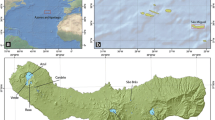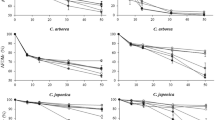Abstract
As part of the development of rapid assays to measure ecological processes, rates of decomposition of eelgrass,Zostera capricornii, were measured using litter bags placed at different distances from the sea in a coastal lake system. Average loss of dry mass over 28 d in bags with coarse mesh, which excluded animals >1.5 mm, varied from 364 to 448 mg in late winter to between 644 and 868 mg in autumn, depending on locality. Rates of loss were significantly greater in bags with small mesh (0.063 mm), from which all macrofauna were excluded, varying from 420 to 532 mg and from 868 to 924 mg in winter and autumn, respectively. There were consistent negative correlations between loss of litter and numbers of macrofauna and meiofauna in the bags. Rates of decrease in the organic fraction of the litter were positively correlated with numbers of animals. The results imply that the fauna inhibited decomposition, possibly by reducing microbial populations through grazing.
Similar content being viewed by others
Literature Cited
Barajas-Guzman, G. andJ. Alvarez-Sanchez. 2003. The relationships between litter fauna and rates of litter decomposition in a tropical rain forest.Applied Soil Ecology 24:91–100.
Bedford, A. P. 2004. A modified litter bag design for use in lentic habitats.Hydrobiologia 529:187–193.
Bedford, A. P. andP. G. Moore. 1984. Macrofaunal involvement in the sublittoral decay of kelp debris: The detritivores community and species interactions.Estuarine Coastal and Shelf Science 18:97–111.
Bradford, M. A., G. M. Tordoff, J. A. Eggers, T. H. Jones, andJ. E. Newington. 2002. Microbiota, fauna and mesh size interactions in litter decomposition.Oikos 99:317–323.
Bruquetas de Zozaya, I. Y. andJ. J. Neiff. 1991. Decomposition and colonization by invertebrates ofTypha latifolia L. litter in Chaco cattail swamp (Argentina).Aquatic Botany 40: 185–193.
Crowl, T. A., H. McDowell, A. P. Covich, and S. L. Johnson. 2001. Freshwater shrimp effects on detrital processing and nutrients in a tropical headwater stream.Ecology 82:775–783.
Cuffney, T. F., J. B. Wallace, andG. J. Lugthart. 1990. Experimental evidence quantifying the role of benthic invertebrates in organic matter dynamics of headwater streams.Freshwater Biology 23:281–299.
Dahms, H. andP. Qian. 2005. Exposure of biofilms to meiofaunal copepods affects the larval settlement ofHydroides elegans (Polychaeta).Marine Ecology Progress Series 297:203–214.
Dye, A. H. 2004. A survey of meiobenthos in the Tuggerah Lakes system, New South Wales. Report for Wyong Shire Council, Centre for Research on Ecological Impacts of Coastal Cities, University of Sydney, Sydney, Australia.
Dye, A. H. 2005. Meiobenthos in intermittently closed/open coastal lakes in New South Wales: Spatial and temporal patterns in densities of major taxa.Marine and Freshwater Research 56:1–13.
Dye, A. H. andF. Barros. 2005a. Spatial patterns of macrofaunal assemblages in intermittently closed/open coastal lakes in New South Wales, Australia.Estuarine Coastal and Shelf Science 64:357–371.
Dye, A. H. andF. Barros. 2005b. Spatial patterns in meiobenthic assemblages in intermittently open/closed coastal lakes in New South Wales, Australia.Estuarine Coastal and Shelf Science 62:575–593.
Fairweather, P. G. 1999. Determining the “health” of estuaries: Priorities for ecological research.Australian Journal of Ecology 24: 441–451.
Fenchel, T. 1970. Studies on the decomposition of organic detritus derived from the turtle grassThalassia testudinum.Limnology and Oceanography 15:14–20.
Frasco, B. A. andR. E. Good. 1982. Decomposition dynamics ofSpartina alterniflora andSpartina patens in a New Jersey salt marsh.American Journal of Botany 69:402–406.
Gallagher, J. L. 1984. Detritus processing and mineral cycling in seagrass (Zostera) litter in an Oregon salt marsh.Aquatic Botany 20:97–108.
Golladay, S. W. andR. L. Sinsabaugh. 1991. Biofilm development on leaf and wood surfaces in a boreal river.Freshwater Biology 25: 437–450.
Graca, M. A. S. 2001. The role of invertebrates on leaf litter decomposition in streams—A review.International Review of Hydrobiology 86:383–393.
Hanlon, R. D. G. andJ. M. Anderson. 1979. The effects ofCollembola grazing on microbial activity in decomposing leaf litter.Oecologia (Berlin) 38:93–99.
Harrison, P. G. 1977. Decomposition of macrophytes detritus in seawater: Effects of grazing by amphipods.Oikos 28:165–169.
Harrison, P. G. andA. T. Chan. 1980. Inhibition of the growth of micro-algae and bacteria by extracts of eelgrass (Zostera marina) leaves.Marine Biology 61:21–26.
Harrison, P. G. andK. H. Mann. 1975. Detritus formation from eelgrass (Zostera marina L.): The relative effects of fragmentation, leaching and decay.Limnology and Oceanography 20:924–934.
Hassall, M., J. G. Turner, andM. R. W. Rands. 1987. The effects of terrestrial isopods on the decomposition of woodland leaf litter.Oecologia (Berlin) 72:597–604.
Heneghan, L., D. C. Coleman, X. Zou, D. A. Crossley, and B. L. Haines. 1999. Soil microarthropod contributions to decomposition dynamics: Tropical-temperate comparisons of a single substrate.Ecology 80:1873–1882.
Hietz, P. 1992. Decomposition and nutrient dynamics of reed (Phragmites australis (Cav.) Trin. Ex Steud.) litter in Lake Neusiedl, Austria.Aquatic Botany 43:211–230.
Holm, S. 1979. A simple sequentially rejective multiple test procedure.Scandanavian Journal of Statistics 6:65–70.
Hunter, M. D., S. Adl, C. M. Pringle, andD. C. Coleman. 2003. Relative effects of macro-invertebrates and habitat on the chemistry of litter during decomposition.Pedobiologia 47:101–115.
Ineson, P., M. A. Leonard, and J. M. Anderson. 1982. Effect of collembolan grazing upon nitrogen and cation leaching from decomposing leaf litter.Soil Biology and Biochemistry 14:601–605.
Irmler, U. 2000. Changes in the fauna and its contribution to mass loss and N release during leaf litter decomposition in two deciduous forests.Pedobiologia 44:105–118.
Kuehn, K. A., M. J. Lemke, K. Suberkropp, andR. G. Wetzel. 2000. Microbial biomass and production associated with decaying leaf litter of the emergent macrophyteJuncus effusus.Limnology and Oceanography 45:862–870.
Lopez, G. R., J. S. Levinton, andL. B. Slobodkin. 1977. The effect of grazing by the detritivoresOrchestia grillus onSpartina litter and its associated microbial community.Oecologia (Berlin) 30: 111–127.
Mann, K. H. 1988. Production and use of detritus in various freshwater, estuarine and coastal marine systems.Limnology and Oceanography 33:910–930.
Mateo, M. A. andJ. Romero. 1997. Detritus dynamics in the seagrassPosidonia oceanica: Elements for an ecosystem carbon and nutrient budget.Marine Ecology Progress Series 151:43–53.
Mathews, C. P. andA. Kowalczewski. 1969. The disappearance of leaf litter and its contribution to production in the River Thames.Journal of Ecology 57:543–552.
Menendez, M., E. Fores, andF. A. Comin. 1989.Ruppia cirrhosa— Decomposition in a coastal temperate lagoon as affected by macro-invertebrates.Archiv fur Hydrobiologie 117:39–48.
Menendez, M., O. Hernandez, N. Sanmarti, andF. A. Comin. 2004. Variability of organic matter processing in a Mediterranean coastal lagoon.International Review of Hydrobiology 89:476–483.
Opsahl, S. andR. Benner. 1993. Decomposition of senescent blades of the seagrassHalodule wrightii in a subtropical lagoon.Marine Ecology Progress Series 94:191–205.
Petersen, H. andM. Luxton. 1982. A comparative analysis of soil fauna populations and their role in decomposition processes.Oikos 39:287–388.
Roberts, D. E. 2001. Tuggerah Lakes Estuary Process Study. Wyong Shire Council Sydney, Australia.
Robertson, A. I. 1988. Decomposition of mangrove leaf litter in tropical Australia.Journal of Experimental Marine Biology and Ecology 116:235–247.
Romero, J., G. Pergent, C. Pergent-Martini, M. Mateo, andC. Regnier. 1992. The detritic compartment in aPosidonia oceanica meadow: Litter features, decomposition rates and mineral stocks.P.S.Z.N.I. Marine Ecology 13:69–83.
Scott, A. 1999. Ecological history of the Tuggerah Lakes, Final report. Commonwealth Scientific and Industrial Research Organization, Land and Water Technical Report 18/99. Sydney, New South Wales.
Stockley, R. A., G. S. Oxford, andR. F. G. Ormond. 1998. Do invertebrates matter? Detrital processing in the River Swale-Ouse.The Science of the Total Environment 210:427–435.
Twilley, R. R., G. Ejdung, P. Romare, andW. M. Kemp. 1986. A comparative study of decomposition, oxygen consumption and nutrient release for selected aquatic plants occurring in an estuarine environment.Oikos 47:190–198.
Van der Valk, A. G. andP. M. Attiwill. 1984. Decomposition of leaf and root litter ofAvicennia marina at Westernport Bay, Victoria, Australia.Aquatic Botany 18:205–221.
Williams, J. I.. 2002. Effects of the tropical freshwater shrimpCaridina weberi (Atyidae) on leaf litter decomposition.Biotropica 34:616–619.
Wright, M. S. andA. P. Covich. 2005. The effect of macroinvertebrate exclusion on leaf breakdown rates in a tropical headwater stream.Biotropica 37:403–408.
Zimmer, M., G. Kautz, and W. Topp. 2005. Do woodlice and earthworms interact synergistically in leaf litter decomposition?Functional Ecology 19:7–16.
Zimmer, M., S. C. Pennings, T. L. Buck, andT. H. Carefoot. 2004. Salt marsh litter and detritivores: A closer look at redundancy.Estuaries 27:753–769.
Author information
Authors and Affiliations
Corresponding author
Rights and permissions
About this article
Cite this article
Dye, A.H. Inhibition of the decomposition ofZostera capricornii litter by macrobenthos and meiobenthos in a brackish coastal lake system. Estuaries and Coasts: J ERF 29, 802–809 (2006). https://doi.org/10.1007/BF02786531
Received:
Revised:
Accepted:
Issue Date:
DOI: https://doi.org/10.1007/BF02786531




